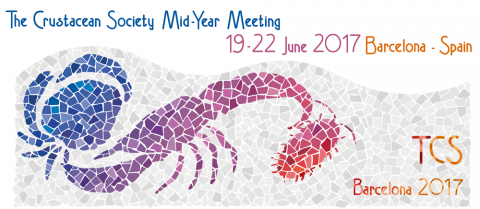
The Crustacean Society Mid-Year Meeting will take place in Barcelona (Spain), from 19th to 22th June 2017.
Meeting organized by the TCS (The Crustacean Society) on these topics: Behaviour/Physiology, Conservation Biology, Ecology, Fisheries/Aquaculture, Genomics/Population Genetics, Global change/ Invasive species, Larvae, Systematics/Phylogeny/Biogeography.
- High-resolution analysis of phosphorus in gastroliths, decapod calcium storage biominerals
Gilles Luquet1, Andreas Ziegler2, Céline Paris3, Aline Percot3, Murielle Salomé4, Yannicke Dauphin5, Marta Potocka6, Jaroslaw Stolarski6
1 UMR CNRS 7208, BOREA, Museum National d'Histoire Naturelle, Paris, France
2 Central Facility for Electron Microscopy, University of Ulm, Germany
3 UMR MONARIS, Université Pierre et Marie Curie, Paris, France
4 ID21, European Synchrotron Radiation Facility-ESRF, Grenoble, France
5 UMR ISYEB, Mammifères et Oiseaux, Museum National d'Histoire Naturelle, Paris, France
6 Institute of Paleobiology, Polish Academy of Science, Warsaw, Poland
Abstract:
Some crustaceans elaborate calcium deposits during each premolt period as a reservoir of calcium ions for beginning the calcification of the new cuticle. For example, crayfish, lobsters, Norway lobsters and land crabs elaborate such structures, called gastroliths, in their stomach wall. If these biominerals are mostly made of amorphous calcium carbonate, phosphate has also been evidenced in the mineral phase. On the other hand, phosphorylated proteins have been identified in the matrix gastroliths of crayfish. We analyzed the presence, localization and role of the phosphorus element in gastroliths of crayfish, lobsters and land crabs. EDX, Raman and XANES analyses were performed to detect and analyze in situ the phosphorus-containing molecules. Whatever the technique used, P is always detected, in the mineral and/or the organic phase. Diverse roles for the phosphate molecules are considered: involvement in the formation of the mineral phase, reservoir of phosphate ions used in the mineralization of the cuticle, which not only contains calcium carbonate (ACC and calcite) but also calcium phosphate (ACP and carbonate apatite).
- The "Pinocchio-shrimp effect", or how environment affects rostrum morphology in freshwater shrimps (Decapoda: Atyidae: Caridina)
Valentin Seizilles de Mazancourt1, Gérard Marquet & Philippe Keith1
1 UMR CNRS 7208, BOREA, Museum National d'Histoire Naturelle, Paris, France
2 Museum National d'Histoire Naturelle, Paris, France
Abstract:
External morphology has always been the first criterion used to separate species of shrimps, especially in the freshwater genus Caridina H. Milne-Edwards, 1837, but more doubts have been expressed regarding the relevance of some of the morphological characters. We collected 27 specimens of Caridina from seven different localities during field work conducted on the island of Pohnpei (Federated States of Micronesia). After genetic verification that they all belonged to the same species, 19 morphological variables were measured and correlated with the elevation of the collecting stations using correlation analyses. We provide evidence that the length of the rostrum showed strong negative correlation with the elevation. This could be explained either by the physical stress exerted on the rostrum by the stronger water currents in the stations at a higher elevation, as a defence against predators in the lower stations, or a combination of both possibilities. The taxonomy of these shrimps is thus challenging and should not rely only on rostrum length, but on other characters such as the number of teeth on the dorsal margin of the carapace, which is not correlated with rostrum length and therefore, with the environment.
